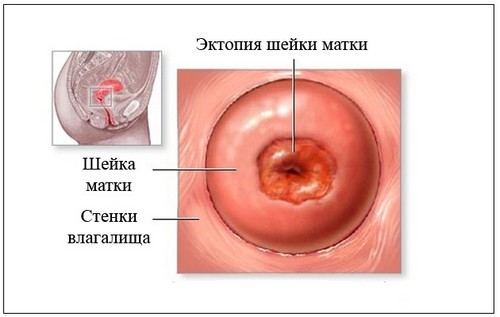In our 21st century, many women after the first-born are diagnosed with cervical erosion. For some, this sounds like a sentence, because they do not know what the disease is and how it is treated.
Cervical erosion (ectopia) is a disease caused by a defect in the cervical mucosa. This is considered a pathological benign process.
Real erosion is a bright red spot located on the mucous membrane of the cervix. The defect is formed due to tissue trauma, in which epithelial cells are rejected.
When the epithelium becomes thinner, a bleeding wound remains in its place, which can easily become infected. Sometimes after intercourse a woman complains of bloody discharge.
Cases of infection attachment to erosion are not rare.
For what reasons the disease develops
The reasons can be very different. But the most common are:
- Diseases of the genital area. For example, urogenital chlamydia, trichomoniasis, ureplasmosis, mycoplasmosis, gonorrhea, papillovirus infection, vaginosis or thrush.
- Too early sex life. By itself, the mucous membrane matures only by 20 years. If an infection earlier than this age enters the mucous membrane of the uterus, a high probability of erosion develops.
- Injury. This is mainly trauma after childbirth or abortion. Quite often, the cervical mucosa is torn during childbirth.
- Decrease in the general immunity of a woman’s body, against which erosion occurs.
- Frequent change of partners.
- Various hormonal disorders, malfunction in the menstrual cycle.
Types of uterine erosion
- Congenital erosion. It is detected in children or adolescents. As a rule, the symptoms are blurry or completely absent. Erosion is detected during colposcopy. Congenital erosion, as a rule, is not treated.
- True erosion. Most often localized in the area of the pharynx. This type of erosion is characterized by a small lesion, which sometimes bleeds. Such erosion occurs with symptoms of endocervicitis with purulent discharge. The disease lasts no more than 2 weeks.
- Pseudo-erosion. Its manifestations are diverse. Sometimes it can be round in shape with a pronounced red color, but in most cases it has no shape. The size varies from a few millimeters to several centimeters. On the surface of the defect, mucous discharge can be detected, which can be purulent. The duration of this process is up to several months. She is dangerous relapse.
- Entropion. It is characterized by an eversion of the cervical canal. The reasons are abortion and childbirth.
- Cervical endometriosis. This is the process of transplantation or attachment to the surface of the cervix of the uterus of the endometrium that lines the uterine cavity.
- Polyps of the cervix or cervical canal.
- Leukoplakia. The keratinization of the squamous epithelium occurs.
- Genital warts.
How is the disease manifested?
The disease does not have a pronounced symptomatology. Most often, the diagnosis is made on the basis of a gynecological examination at the reception.

But still, you should consult a doctor if the following signs appear:
- During intercourse, pain and discomfort occur;
- Non-menstrual bleeding. More likely to appear after intercourse.
- Pathological discharge of a mucopurulent or purulent nature. Women often confuse such discharge with thrush, menstruation, or harbingers of miscarriage.
How is the disease diagnosed?
The diagnosis of cervical erosion is made by a gynecologist. The basis for the statement is a gynecological examination, in which you can see the inflamed, sometimes bleeding area of the cervical mucosa.
For an accurate diagnosis, additional research is possible – colposcopy. This method includes a thorough study of the defect on the cervix, using a colposcope device.

To identify the causes of erosion, the doctor may prescribe:
- A series of tests for sexually transmitted diseases. For example, gonorrhea, trichomoniasis, chlamydia, herpes virus, mycoplasmosis.
- A smear from the vaginal wall of the cervix and vaginal mucosa. These swabs help establish the degree of purity of the vagina. The degree of purity is the number of pathogenic bacteria and beneficial lactobacilli living on the mucous membrane. There are 4 degrees of purity. 3-4 degrees speak of inflammatory processes, for example vaginitis.
- The cultural research method consists in sowing scrapings from the walls of the vagina on special nutrient media.
Additional research methods include:
- A cervical biopsy is the taking of a small piece from the cervix, which is then examined in a laboratory under a microscope. A biopsy is the most accurate method for detecting cancer.
- Cytological examination consists in the study of cells of the cervical mucosa.
To treat or not to treat
It is believed that women who have not given birth may not treat erosion. But this is a big mistake. If you start the process, there is a chance of dangerous complications. For example, untreated erosion may not bother a woman for a long time, but after a time when she wants to give birth, scars may form on the cervix, which can complicate the course of labor.
The worst complication is the deification of the process. When dysplasia or a change in epithelial cells occurs, which means a precancerous condition. Therefore, if erosion occurred before or after childbirth, it must be treated.
Postpartum erosion and new pregnancy
Erosion itself does not affect pregnancy in any way, so they prefer not to treat it before delivery. Some women care about whether previously treated erosion will affect pregnancy and is it possible to give birth with erosion? Here you can not worry. This does not affect the well-being of the fetus during pregnancy either. Erosion does not increase the risk of cervical rupture during childbirth.
If erosion has already been treated before, then the outcome of childbirth depends on the method of treatment. Indeed, scars may remain on the uterus that make it difficult to open the cervix at the time of delivery. Therefore, to ensure that childbirth after treatment of erosion passes without complications, you should carefully consider your health. When planning a pregnancy, undergo a full examination and treat erosion.
Treatment methods
There are several treatments available. These include:
- Cryotherapy is a modern method of treating cervical erosion. The method is based on the use of liquid nitrogen. This procedure is almost painless. With improper or unqualified conduct, a scar can form, which is dangerous during childbirth.
- Electrocoagulation – this method has been used for a long time. Electrocoagulation is the cauterization of erosion by electric current. Unfortunately, this method is painful and leaves scars on the cervix, which complicates the birth.
- Chemical coagulation. The method consists in treating the affected area with special chemicals. These drugs include Solkovagin. This is the easiest method, but almost not effective. This type of coagulation is suitable only for surface erosion.
- Laser Therapy An effective way to treat erosion.
- Radio wave surgery. Non-contact method of treatment of erosion. Special radio waves penetrating deep into the cell, contributes to its destruction and evaporation.
- Locally, the doctor may prescribe various ointments, suppositories, or solutions. With erosion caused by an infection (trichomonas, chlamydia), antibacterial drugs are prescribed.
Alternative methods of treatment
Before using various methods of alternative treatment, consult with your gynecologist.
For douching, use the following tinctures:
- Take 1 teaspoon of calendula and pour a glass of boiling water.
- Pour a teaspoon of eucalyptus with a glass of water.
- Pour elm bark 20 g with a glass of hot water. Heat and simmer for about 30 minutes. Strain the broth and dilute with water.
- Bring chamomile, sage, birch leaves, bark, marigold flowers, lavender and bird cherry flowers each 15 g brew a liter of hot water. Darken the resulting mixture for about 3 hours.
In the form of tampons:
- Sea buckthorn oil is a good help in cases of cervical erosion. Insert swabs with oil up to 10 days. This method is safe during pregnancy.
- In half a glass of water, dissolve 2.5 g of the mummy, moisten the swab and enter overnight.
- Take propolis 15 ml. 20% tinctures and calendula. Mix them with 60 g of lanolin. Enter the swab with the resulting ointment for 12 hours.
Remember, before treating erosion with alternative methods, be sure to go to the gynecologist. It is the doctor who will be able to accurately diagnose the disease and prescribe effective treatment. Take care of yourself and be healthy!



